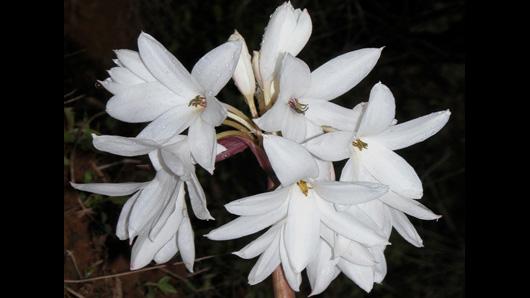Geography and distribution
Restricted to the North Western Ghats of western India, where it occurs in three areas:
It is usually found on lateritic plateaus along the margins of stunted, semi-evergreen forest, and more rarely on hill slopes.
It has been found growing in association with Adelocaryum coelestinum, A. malabaricum, Crinum woodrowii, Curculigo orchioides, Curcuma caulina, C. neilgherrensis, Euphorbia nana, Habenaria brachyphylla, H. grandifloriformis, Ledebouria species , Pimpinella heyneana, Pinda concanensis, Pteris quadriaurita and Strobilanthes reticulata.
Description
Overview: A bulbous herb, 30-60 cm high, with an ovoid bulb 5-8 cm across.
Leaves: The leaves develop after the flowers, and are erect, then recurved, folded, bright to dark green, linear-oblong, moderately firm, with a smooth margin and an obtuse (blunt) apex.
Flowers: The scape (leafless flower stalk) is stout, almost circular in cross-section and 30-60 cm long.
The fragrant flowers are borne in an umbel (of 5-20 individual flowers). The spathe (sheathing bract) bears two valves, is lanceolate and 3-5 cm long. The bracts are awl-shaped or thread-like. The pedicel (individual flower stalk) is as long as the ovary. The perianth (petals and sepals) is funnel-shaped and the tube is slightly curved, greenish, and 3-5 cm long. It has six lobes, which are pure white, oblanceolate to oblong, obtuse, cuspidate (abruptly tipped with a sharp, rigid point) and about 5 x 2 cm long, many times longer than the stamens.
The six stamens are attached to the throat of the perianth tube. The filaments are short (about 1 cm long), and are attached to the tube. The pollen grains are mono-aperturate (have a single opening), ovoid, 50 x 55 µm. The exine (outer wall) is micro-verrucate (warty) with bulbous excrescences (outgrowths). The ovary is about 1 cm long and slender. The style is shorter than the stamens and the stigma is shortly three-lobed.
Fruits: The fruit is sub-globose.
Flowering and pollination
Flowering begins in May and June, and fruiting takes place from June onwards.
Stingless bees ( Trigona species) and jewel beetles forage on this species and probably act as pollinators. However, detailed pollination studies are urgently needed.
Seed dispersal is by atelechory (dispersal over a short distance, in this case aided by rain-wash). The Mahabaleshwar and Kas areas receive a significant annual rainfall of about 6,000 mm during the south-west monsoon (June-August).
Threats and conservation
Threats to Crinum brachynema populations include harvesting of bulbs from the wild for sale in local markets (for medicinal and ornamental purposes), repeated forest fires and the depletion of areas of potential habitat due to landslides.
Cultivation and re-introduction
Although Critically Endangered in the wild, Crinum brachynema shows very good seed-set in cultivation. There is an urgent need to harvest seeds from the wild and germinate them under nursery conditions, for subsequent cultivation in glasshouses and gardens, and eventual re-introduction of the species to suitable habitats.
Uses
Crinum brachynema has beautiful foliage, and merits wider use as a cultivated ornamental. The attractive, fragrant flowers could be used commercially in the pharmaceutical and perfume industries.
This species at Kew
Crinum brachynema is not currently grown at Kew, but other species of Crinum can be seen growing in the Palm House and Temperate House.
Pressed and dried specimens of Crinum brachynema are held in Kew's Herbarium, where they are available to researchers, by appointment. The details of some specimens of other Crinum species can be seen online in the Herbarium Catalogue.





